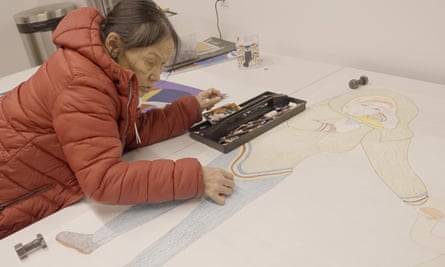It’s hard to comprehend what life is like in Kinngait, a chilly hamlet home to a thriving artist cooperative in the Arctic north of Canada. It’s currently the depths of winter there, with an average temperature of -20C and just four to five hours of daylight. Challenging conditions for an artist, I think to myself, casting my mind to the premium placed on large windows and natural light in studios closer to home.
As it turns out the challenge here isn’t so much making work as making it to work: in these parts the darkness acts as a nifty cover for polar bears who are prone to wander in and out of town uninvited. You’ll find those outsized interlopers in the imaginative drawings of Shuvinai Ashoona, the celebrated third-generation Inuit artist who received a special mention at the 2022 Venice Biennale, and who has a solo show opening at the Perimeter in London this week. It’s not just polar bears: we also get whales, walruses, seals – though not as we know them. Ashoona takes as her inspiration the natural ice-scape and a childhood spent camping and clamming, and on vast sheets of white paper gives them her own fantastical twist. Luminescent fish flop about on ice. Giant squid have human faces for eyes. Dreamlike gatherings take place between shapeshifting creatures.
Ashoona was born in Kinngait, formerly known as Cape Dorset, in 1961, the oldest of 14 children, three of whom died at birth. She grew up between the rocky town and remote outpost camps, at once watching television like any other teenager and living a more nomadic life of boating and berry-picking in the surrounding caribou-dotted hills. “A balance that came naturally to my family,” she tells me over email. She was among the first cohort of children to attend primary school in Kinngait, and one of few students to attend high school in Iqaluit, a two-hour flight away. When she was 16, she gave birth to a daughter, Mary.
Ashoona’s father was a hunter and master carver, her mother a graphic artist. Her grandmother made more than 8,000 drawings during her 25-year career. It wasn’t until the mid-1990s, though, that Ashoona picked up a pencil herself. She’d been struggling with her mental and physical health, and her younger sister, Goota, suggested it might help, and also earn her money for food and cigarettes – “smoke money,” Ashoona calls it. And so, she too got involved with the West Baffin Eskimo Cooperative, the community-owned cultural institution that has fostered five generations of Inuit artists. “I sold a drawing for $15,” she says. “And in return they gave me a bigger piece of paper.”
Without formal training, Ashoona learned like her relatives – by observing and imagining. Using a fineliner pen, she started out producing delicate black-and-white drawings that gradually became richer and more detailed. By the mid-2000s, she’d introduced coloured pencils, a mix of earthy browns and greys plus neon lilacs, limes and yellows. Globes and oceans began to appear – a nod to the changing climate and the world opening up before her – as well as spirits from Inuit mythology, including the sea goddess Sedna. The work she produces now is complex and layered, featuring seabird’s-eye views and drawings within drawings. When I ask Ashoona how she would describe her artistic development, she tells me it’s “fun, fun, fun”, that she feels she “can draw for ever”.
Rooted in Inuit traditions and storytelling, Ashoona’s art has a dreamlike quality and the feel of her vibrant drawings capture the history and contemporary experience of everyday Inuit life. When she doesn’t show up for our video call – schedules in Kinngait are fluid, to say the least – I wind up chatting with Juumi Takpaungai, the studio’s friendly associate arts manager. He describes the way Ashoona works: “Wafting around, thinking, looking at books maybe, then it spills from her mind straight on to the page.” She doesn’t do preliminary sketches, and she doesn’t take direction.

The absence of outside influence is one of the benefits of making work where she does, in one of the world’s most improbable art hubs. Located at the southern tip of Baffin Island, 1,300 miles north of Ottawa, Kinngait is reachable by small prop planes. Within the town, the only modes of transport are quad bikes and snowmobiles, and beyond it there are no roads. Though the residents have access to contemporary culture via the internet, travel is difficult. Ashoona doesn’t visit exhibitions or keep up with the art market. She isn’t trying to conform to ideas of what art today should be.
It’s thanks to the cooperative – an intermediary between the artists in Kinngait, which make up roughly a quarter of the 1,400 inhabitants, and the rest of the world – that the work of Ashoona and others is seen. Since it was founded in 1959, it’s been a crucial financial resource for the community, bringing in money from the sale of drawings and prints, which are shipped to a wholesale showroom in Toronto, from where they reach gallerists and dealers. Perhaps most importantly, the self-governed studios provide a sense of stability and camaraderie – something that in this isolated part of the world can be nothing short of life-saving.
I ask Ashoona if she ever imagines what her life – and her art – might look like outside Kinngait, and if she’s ever been tempted to leave. She doesn’t hesitate: “I never intend to leave Kinngait. It’s my one and only home.”

